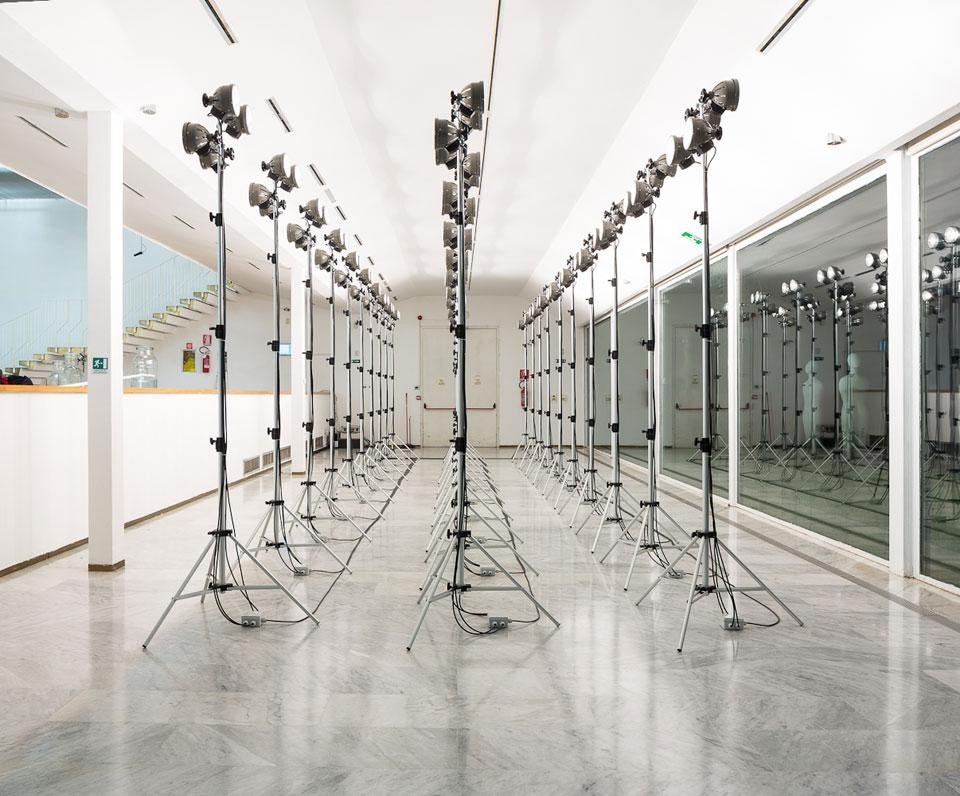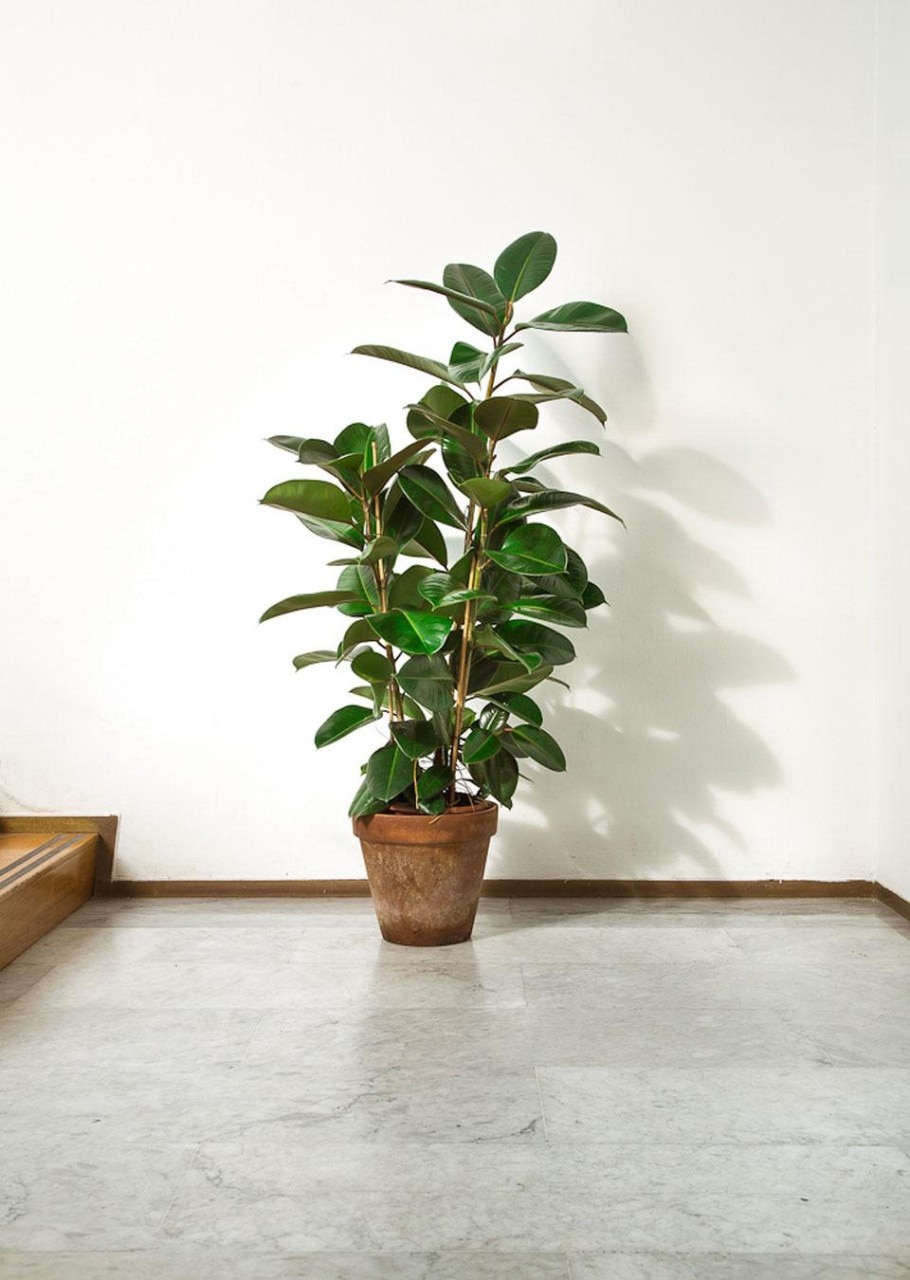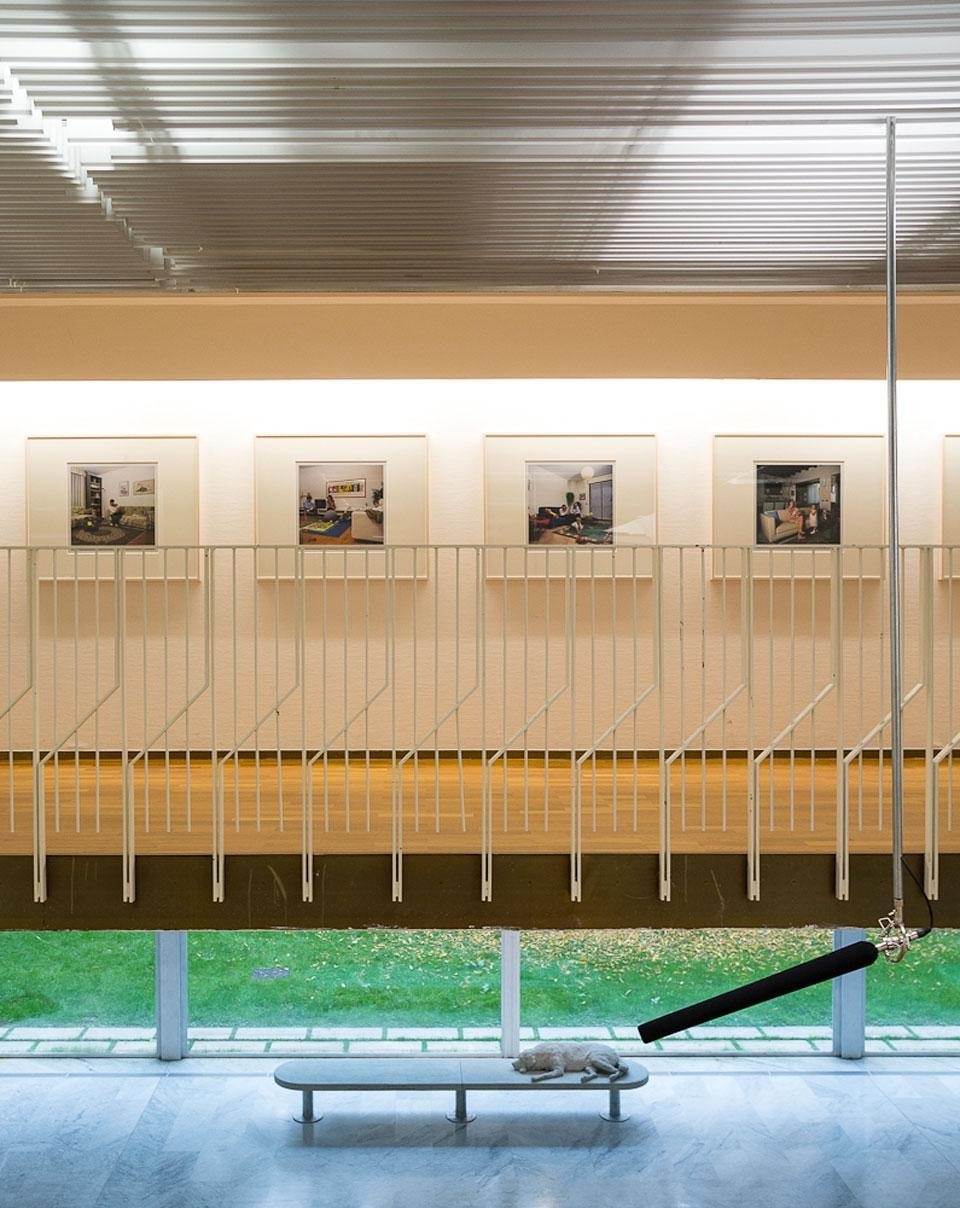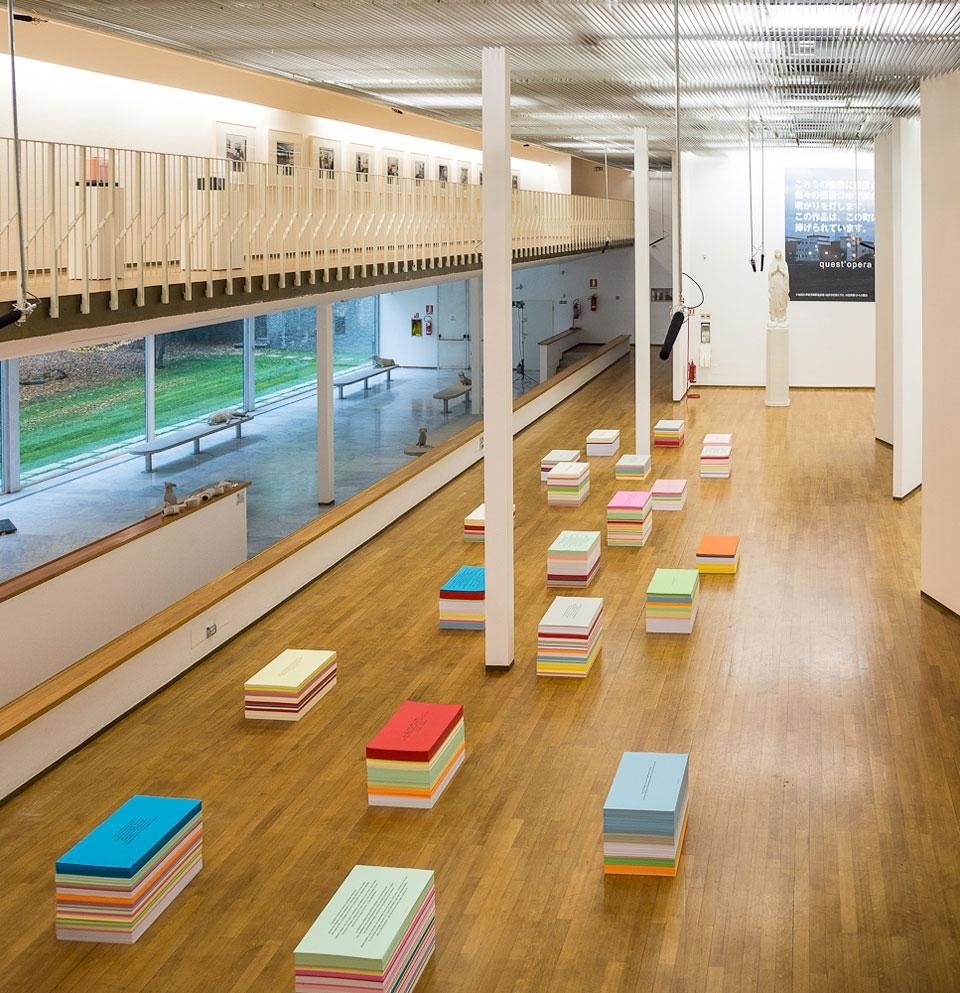Like a single large work, articulated in a series of steps corresponding to past works, dating back to 1974 and condensed in works conceived for PAC, the exhibition sets up a sensible dialogue with the architecture of Ignazio Gardella and makes the visitor immediately aware of his own role in producing meaning, beginning with an installation that consists of microphones distributed around the space that are active during the full exhibition run.
Curated by Paola Nicolin and Hans Ulrich Obrist, the show is accompanied by a monograph that for the first time brings together Garutti's complete works, published by Mousse Publishing and Walther Koening Verlag.
We met Alberto Garutti at PAC to hear some of his thoughts about the works on show. They are brought to you here in the form of notes, as if they were a transcription of a partial and spontaneous audio-guide.

The microphone piece is the key work in the exhibition, asking the viewer to assume responsibility for his role. It is a work that modifies their behaviour, it can become a performance, taking the idea of the present into it, updating the old works. When they write about my work, very often they dwell on the most superficial aspect, the seemingly sentimental one. In reality every public work is based on a methodology that applies the notion of there being two sides to the coin.
The first is territory, you need to understand it in such a way that it is rooted in territory (relationships with citizens), which I use in a Machiavellian way to arrive at the second side: to perform an operation that is very contemporary from the linguistic angle and contains a strong criticism of a certain way of making public art.
The microphone piece also works in this way. While in the city the artist has to go towards the viewer, towards the citizen, in the museum it is the viewer that has to assume responsibility. A book will be made of all the recordings, a book that according to Obrist will be the top book around the world.

The empathic relationship with PAC is a reflection of my great respect for modernist architecture in the city, with its gardens that grow inside (…). In the 1950s it was all the rage to put a rubber plant in your home; the piece that I have dedicated to PAC, as well as being a work of art, reflects on the relationship between nature and architecture with the urban structure of the city, and is a homage to Gardella. In some of the photographs taken at the time of the opening the museum did actually have some of these plants.
I THINK I REMEMBER (1974)
Domestic space is never articulated in an intimate manner. It is the place where in the past we placed ourselves in relation to the world. A mediated world that we had in the home that was made up of the TV, the answering machine… Now we have it in our pockets. Looking back I see lots of things that I didn't see before but that I took forward by trusting my feelings. At the time I suffered the dogmatic dimension of political action at all costs, this was also the reason I turned to the domestic dimension. Looking at these objects, isolating them, was a bit disconcerting at the times when the "I" was overpowered by the "we". I dealt with immobility.
At the time I suffered the dogmatic dimension of political action at all costs, this was also the reason I turned to the domestic dimension
![Alberto Garutti, <em>Il cane qui ritratto appartiene a una delle famiglie di Trivero. Quest'opera è dedicata a loro e alle persone che sedendosi qui ne parleranno</em>, ["The dog portrayed here belongs to one of the families in Trivero. This work is dedicated to them and those who sitting here will talk about it"] 2009. Courtesy Fondazione Zegna Alberto Garutti, <em>Il cane qui ritratto appartiene a una delle famiglie di Trivero. Quest'opera è dedicata a loro e alle persone che sedendosi qui ne parleranno</em>, ["The dog portrayed here belongs to one of the families in Trivero. This work is dedicated to them and those who sitting here will talk about it"] 2009. Courtesy Fondazione Zegna](/content/dam/domusweb/en/art/2013/01/08/alberto-garutti-didascalia-caption/big_402395_6093_04-Delfino-Sisto-Legnani-61301.jpg.foto.rmedium.jpg)
Orizzonte in some ways precludes the public works because it is a whole made up of unity, it already speaks a language that takes account of the plurality of relationships. Each piece constitutes an ideal horizon line in my life, that is made up of the people that have marked it.
Matasse is along the same lines, what keeps together two people, two places. It tries to make a relationship physical. The works about distance (Matasse, Campionario) refer to the whole distance effectively travelled, on foot, by bicycle or in the car and reflect empirical measurements, pre Google maps. Campionario is a piece about the economy, on the reaction with respect to the client: they are kind of "stamps".
![Alberto Garutti, <em>Didascalie</em>, ["Captions"], 2012. Courtesy Massimo Minini Alberto Garutti, <em>Didascalie</em>, ["Captions"], 2012. Courtesy Massimo Minini](/content/dam/domusweb/en/art/2013/01/08/alberto-garutti-didascalia-caption/big_402395_8517_05-Delfino-Sisto-Legnani-62521.jpg.foto.rmedium.jpg)
Temporali is a series of works that talks about the Universe. I'm thinking about the breakthrough of architecture itself or about Andrea Pozzo, Sant'Ignazio, Caravaggio. Above all this curious thing of relating to the Universe, to this inconceivable enigma, as Borges defined it, that sits in our head and that has everything to do with art. One then dreams up the mythological legend of Zeus, or the Eternal Father for those who believe. Instead I thought about nature. I wrote somewhere that art contains the mystic sense of nature.
TUTTI I PASSI CHE HO FATTO NELLA MIA VITA MI HANNO PORTATO QUI, ORA ["All the steps that I have taken in my life have led me here, now"] (2007)
This flat writing on the floor speaks continually of individual experiences. It speaks to the person who reads it. It can be anywhere, in some way it is drawn into everyone's world. It is a condenser of existences, a kind of metronome. The more one realises, the more it produces meaning.
![Alberto Garutti, <em>Bacheche progetti opere pubbliche</em>, ["Showcases projects public works"], 1994-2010. Courtesy Galleria Massimo Minini Alberto Garutti, <em>Bacheche progetti opere pubbliche</em>, ["Showcases projects public works"], 1994-2010. Courtesy Galleria Massimo Minini](/content/dam/domusweb/en/art/2013/01/08/alberto-garutti-didascalia-caption/big_402395_5056_06-Delfino-Sisto-Legnani-63311.jpg.foto.rmedium.jpg)
Captions are the attracting mechanism of the work. On the one hand they let people understand how the operation (not the work) functions, they are a going towards, on the other they are about method. The contemporary work of art is hidden, it is concealed in reality, because in an increasingly media-orientated society everything is public. Contrary to what Duchamp did, today the work of art risks wanting to go out of the museum and losing its aura. To ensure that this does not happen, it is for us viewers, starting with the artist (who is the first viewer), to charge our vision with a sense of aura, to look at things in an artistic sense. It is therefore overall a case of a methodological approach.
![Alberto Garutti, <em>Orizzonte</em>, ["Horizon"] 1988. Courtesy of the artist. Private collection Alberto Garutti, <em>Orizzonte</em>, ["Horizon"] 1988. Courtesy of the artist. Private collection](/content/dam/domusweb/en/art/2013/01/08/alberto-garutti-didascalia-caption/big_402395_2111_07-Delfino-Sisto-Legnani-63841.jpg.foto.rmedium.jpg)
The pieces at the entrance to the exhibition bring out all the methodological design aspect that is part of my work. The work is made up of method, how to make the production budget available to give back to citizens a place that is very dear to them.
![Alberto Garutti, <em>Recinzione</em>, ["Fence"] 2012. Courtesy Franco Soffiantino. Contemporary Art Productions Alberto Garutti, <em>Recinzione</em>, ["Fence"] 2012. Courtesy Franco Soffiantino. Contemporary Art Productions](/content/dam/domusweb/en/art/2013/01/08/alberto-garutti-didascalia-caption/big_402395_4541_08-Delfino-Sisto-Legnani-60781.jpg.foto.rmedium.jpg)
Alberto Garutti. Didascalia / Caption
PAC Padiglione d'Arte Contemporanea
Via Palestro 14, Milan



